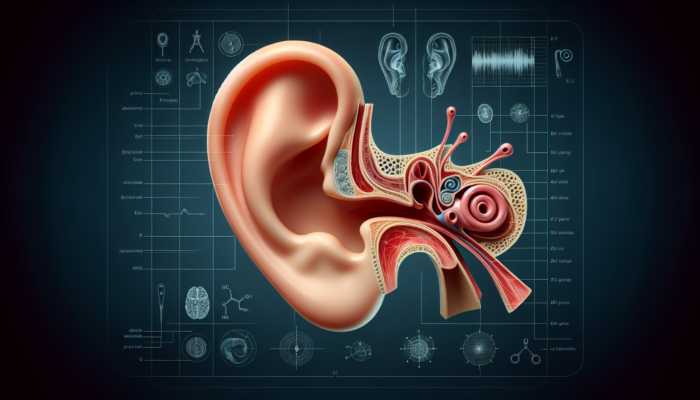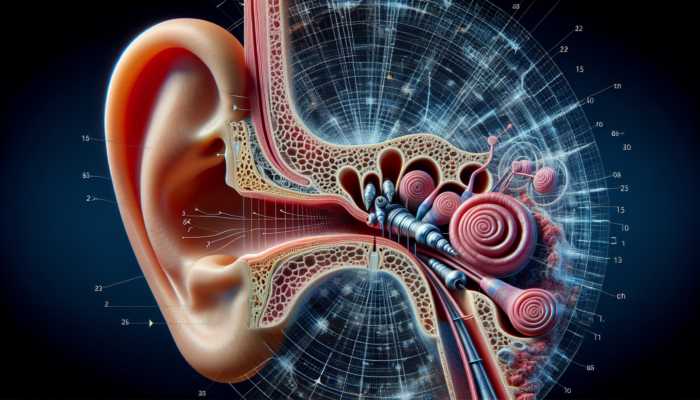Comprehensive Overview of the Inner Ear Anatomy
Understanding the Structure and Function of the Cochlea

The cochlea is an extraordinary spiral-shaped structure located within the inner ear, serving a fundamental role in our auditory perception. Its complex architecture enables the conversion of sound vibrations into electrical signals, which are subsequently relayed to the brain for interpretation. This transformation is essential; without it, the subtleties of sound would remain inaccessible to us. The cochlea comprises three primary chambers: the scala vestibuli, scala tympani, and scala media, all filled with fluid and lined with specialized hair cells that respond to sound waves. As sound travels into the cochlea, it generates pressure waves that move through these fluids, bending the hair cells, which then produce electrical impulses sent to the auditory nerve.
A thorough understanding of the cochlea’s anatomy not only illuminates its critical function but also underscores its fragility. Various factors, including aging, prolonged exposure to loud noises, and specific health conditions, can inflict damage on these delicate hair cells, resulting in hearing loss. Research indicates that noise-induced hearing loss can occur from exposure to sounds exceeding 85 decibels, a common occurrence in many environments around the globe, from concerts to bustling urban streets. Thus, fostering awareness about safe listening practices is crucial for safeguarding cochlear health, enabling individuals worldwide to appreciate the rich tapestry of sounds throughout their lives.
Navigating the Vestibular System for Balance and Orientation
The vestibular system, nestled within the inner ear, is indispensable for maintaining balance and spatial orientation. It consists of several intricate structures, primarily the semicircular canals and otolith organs, which collaborate to detect head movements and changes in body position. The semicircular canals, filled with fluid, are specifically designed to sense angular motion, while the otolith organs are adept at detecting linear movements and the effects of gravity. This information is vital for everyday activities, including walking, running, and more complex movements such as dancing or engaging in sports.
Globally, the significance of the vestibular system is evident across various contexts. For instance, athletes participating in sports like gymnastics or figure skating depend heavily on their vestibular sense to maintain balance and execute precise movements. Similarly, individuals residing in regions with diverse terrains, such as mountainous areas, must navigate challenging landscapes, making a well-functioning vestibular system essential for safety and mobility. Disorders affecting this system can lead to symptoms like dizziness or imbalance, which can have a profound impact on quality of life and daily functioning.
Exploring the Role of the Auditory Nerve in Sound Transmission
The auditory nerve serves as a vital channel for transmitting sound information, conveying electrical signals from the cochlea to the brain, where these signals are interpreted as sound. This nerve is an integral component of the central nervous system, playing a crucial role in facilitating the intricate experience of hearing. The seamless connection between the cochlea and the auditory cortex ensures that even the most complex sounds—ranging from a symphony to the rustling of leaves or the voice of a loved one—are perceived with clarity and precision.
However, various conditions affecting the auditory nerve can pose significant challenges, including hearing loss and auditory processing disorders. Populations worldwide may encounter numerous risks to their auditory health, from industrial noise in urban environments to untreated ear infections in rural areas. Advances in medical technology, such as the development of cochlear implants, have emerged as groundbreaking solutions for individuals experiencing severe hearing impairments, allowing them to reconnect with the world of sound in transformative ways that were previously deemed impossible.
In-Depth Analysis of the Outer Ear Anatomy

The Essential Function of the Pinna in Sound Capture
The pinna, also known as the auricle, is the outermost part of the ear, playing a crucial role in capturing sound waves from the surrounding environment. Its unique shape functions as a funnel, directing sound waves into the ear canal. The distinct contours and folds of the pinna not only facilitate effective sound collection but also enhance our ability to discern the direction from which sounds originate, an essential aspect of auditory perception.
Globally, the anatomical design of the pinna varies across populations, shaped by evolutionary and environmental influences. For instance, individuals residing in densely forested regions may exhibit slightly different ear shapes compared to those in open plains. This adaptation highlights the intricate relationship between anatomy and environmental factors, emphasizing the importance of understanding such variations in fields like anthropology and audiology. Furthermore, congenital ear deformities can significantly impact sound collection and localization, underscoring the necessity for customized auditory solutions worldwide.
Understanding the Structure and Function of the Ear Canal
The ear canal is a tubular structure extending from the pinna to the eardrum, playing an essential role in the transmission of sound. This passage not only channels sound waves but also amplifies them before they reach the eardrum, enhancing auditory perception. The unique shape and length of the ear canal are specifically designed to optimize sound amplification, ensuring that even the faintest sounds are detected effectively.
An interesting aspect of the ear canal’s structure is its protective function. The canal is lined with skin that produces cerumen, commonly known as earwax, which serves multiple purposes: trapping dust, debris, and microorganisms while providing a barrier against infections. Globally, earwax impaction is a prevalent issue, with individuals from diverse backgrounds experiencing discomfort and temporary hearing loss as a result. Awareness campaigns promoting ear health and proper cleaning techniques can help alleviate these problems, ensuring that the ear canal remains an effective conduit for sound transmission.
The Critical Role of the Eardrum in Sound Transmission

The eardrum, or tympanic membrane, is a thin yet resilient structure that vibrates in response to sound waves. This vibration is crucial as it translates acoustic energy into mechanical energy, which is subsequently transmitted to the middle ear. The eardrum’s sensitivity is remarkable, capable of responding to a broad range of frequencies, enabling us to perceive sounds from a mere whisper to the loud crescendo of a concert.
Globally, the health of the eardrum is paramount; various factors such as exposure to loud noises, ear infections, and physical trauma can compromise its integrity. For instance, barotrauma—caused by sudden changes in pressure during air travel—can lead to eardrum perforation, resulting in pain and hearing loss. Awareness and preventive measures, such as using earplugs during flights or swimming, are vital for protecting this essential component of hearing. The eardrum’s role in sound transmission cannot be overstated, as it acts as the gateway to the middle ear and beyond.
Exploring the Complex Anatomy of the Pinna
The anatomy of the pinna is complex, primarily composed of cartilage covered by skin. Its distinctive shape, characterized by various folds and depressions, plays a significant role in sound localization and collection. These anatomical features assist in differentiating between sounds originating from different directions, a skill that is vital for survival and interaction with our environment.
This anatomical diversity is particularly fascinating when examining populations worldwide. For instance, certain cultures may have developed unique modifications to the pinna, whether for aesthetic reasons or to enhance auditory capabilities in specific environments. Additionally, congenital deformities of the pinna can impact sound perception, leading to a deeper understanding of how ear anatomy relates to hearing ability. This knowledge is invaluable in designing effective interventions for auditory impairments, ensuring that individuals can engage fully with their auditory surroundings.
The Protective Features of the Ear Canal
The design of the ear canal serves not only to transmit sound but also to provide a protective barrier. The production of cerumen, commonly referred to as earwax, is a natural defense mechanism. This substance traps dust, foreign particles, and microorganisms, preventing them from reaching the eardrum and reducing the risk of infection. Furthermore, earwax helps keep the skin of the ear canal moisturized, preventing dryness and irritation.
Globally, earwax impaction is a widespread issue affecting many individuals. Excessive wax buildup can lead to discomfort, reduced hearing, and even tinnitus. Education on ear hygiene practices, such as avoiding cotton swabs that can push wax deeper into the canal, is crucial. Additionally, awareness of cultural practices surrounding ear care can inform health interventions. Understanding the balance between natural ear protection and the need for hygiene is essential for maintaining auditory health worldwide.
Key Functions of the Inner Ear
How the Hearing Mechanism Operates
The primary function of the inner ear revolves around the complex hearing mechanism that converts mechanical sound waves into electrical signals. This process begins when sound waves enter the cochlea, where they induce fluid movements. These movements are crucial for the bending of hair cells situated along the basilar membrane within the cochlea. As these hair cells bend, they generate electrical impulses that traverse through the auditory nerve to the brain, where they are decoded as specific sounds.
The efficiency of this hearing mechanism is vital for effective communication and interaction across various environments, whether enjoying music in a concert hall or engaging in conversation within a bustling café. Variations in hearing ability among individuals can emerge from genetic factors, exposure to environmental noise, or lifestyle choices, each influencing how sound is perceived. Globally, many people experience hearing impairments that affect their social lives and professional opportunities, underscoring the importance of accessible hearing health services and education.
The Vestibular System’s Role in Balance and Equilibrium
The vestibular system within the inner ear is a marvel of anatomical engineering, playing a crucial role in maintaining balance and equilibrium. By continuously monitoring head position and movement through the semicircular canals and otolith organs, this system provides the brain with essential information for maintaining stability. When we turn our heads or move our bodies, the fluid within these canals shifts, stimulating hair cells that send signals to the brain about our orientation in space.
This ability to maintain balance is not only essential for athletes or dancers; everyday activities such as walking, climbing stairs, or even standing still heavily rely on our vestibular system. Globally, individuals engaged in occupations requiring physical agility—ranging from construction workers to dancers—must possess a keen sense of balance to perform their tasks safely. Moreover, conditions like vertigo or vestibular disorders can severely disrupt this function, highlighting the need for global awareness and understanding of vestibular health.
Sound Localization: Understanding Direction and Source
An often-overlooked function of the inner ear is its role in sound localization. The inner ear aids in determining the direction and source of sounds by analyzing differences in timing and intensity of sound waves reaching each ear. This ability is critical for navigating our environments, allowing us to respond swiftly to auditory cues.
For instance, in a busy street, the capacity to pinpoint the sound of a honking car or a friend calling from behind significantly enhances our spatial awareness and safety. This function is even more pronounced in the animal kingdom, where certain species can locate prey or predators using advanced auditory skills. Globally, understanding sound localization can inform technologies such as hearing aids and sound systems, enriching the auditory experience for individuals with hearing impairments.
Exploring the Functions of the Outer Ear
The Vital Role of Sound Collection in Hearing
The primary function of the outer ear is to collect and funnel sound waves into the ear canal. This collection process begins with the pinna, which captures sound from various directions and directs it toward the ear canal. The design and shape of the pinna are optimized for enhanced sound collection, maximizing our hearing capabilities, particularly in environments filled with competing sounds.
In diverse locations around the globe, the significance of sound collection extends beyond human communication; it is also critical in wildlife communication and survival. For instance, many animals rely on their outer ear structures to detect environmental sounds—whether it be a predator approaching or their mate calling. The evolutionary adaptations in ear shapes across different species illustrate the importance of sound collection in various ecological niches, further emphasizing the interconnectedness of auditory health.
The Mechanism of Sound Amplification
Sound amplification is a crucial function of the outer ear, where the unique shape of the ear canal enhances the volume of sound waves before they reach the eardrum. This amplification allows even the faintest sounds to become audible, contributing to our rich auditory experiences. The ear canal acts like a resonator, boosting specific frequencies of sound, thereby making it easier to perceive speech or musical notes.
In various cultures, the ability to hear well is often celebrated, from traditional music to oral storytelling, reflecting the deep-rooted significance of sound amplification in social interactions. Understanding how sound amplification functions can also inform the design of hearing aids and other auditory technologies. For individuals with hearing impairments, grasping the mechanics of sound amplification can lead to better management of their auditory health.
The Protective Functions of the Outer Ear Against Debris
The outer ear, including the ear canal, serves as a protective barrier against foreign objects and debris entering the ear. The skin lining the ear canal produces earwax, which traps dust, wax, and microorganisms, preventing them from reaching the delicate structures deeper within the ear. This natural defense mechanism is vital for maintaining ear health and preventing infections.
Globally, awareness of ear protection is essential, particularly in environments with high levels of dust, pollution, or water exposure, such as during swimming. Engaging in preventive practices, such as using earplugs in noisy environments or maintaining proper ear hygiene, can help individuals sustain healthy ears. Understanding the protective functions of the outer ear encourages people worldwide to prioritize ear health and take proactive measures against potential auditory threats.
The Role of the Outer Ear in Sound Localization
The outer ear also plays a significant role in sound localization, aiding in the determination of the source and direction of sounds. The shape of the pinna, combined with the timing and intensity of sounds reaching each ear, allows us to accurately locate where a sound originates—an essential skill for survival and interaction in our environment.
This ability is particularly evident across various global contexts, such as in urban environments where discerning sounds is vital for safety. For example, recognizing the direction of approaching emergency vehicles or identifying familiar voices in crowded spaces relies on effective sound localization. Enhancing our understanding of sound localization can also improve auditory technologies, enriching experiences for individuals with hearing impairments and contributing to safer environments overall.
Common Disorders Affecting the Inner Ear
Understanding Sensorineural Hearing Loss
Sensorineural hearing loss is a widespread condition resulting from damage to the inner ear’s hair cells or the auditory nerve. This type of hearing loss often manifests as difficulty hearing faint sounds or distinguishing speech in noisy environments. Various factors contribute to sensorineural hearing loss, including aging, exposure to loud sounds, and specific medical conditions, such as ototoxicity from certain medications.
Globally, this condition affects millions, creating barriers to effective communication and social interactions. Awareness campaigns aimed at promoting hearing protection in noisy environments, like concerts or industrial workplaces, are critical in preventing this type of hearing loss. Additionally, advancements in hearing aids and cochlear implants provide individuals with sensorineural hearing loss opportunities to regain access to sound, emphasizing the ongoing need for innovation in auditory healthcare.
Exploring Ménière’s Disease and Its Implications
Ménière’s disease is a complex inner ear disorder characterized by episodes of vertigo, hearing loss, and tinnitus. This condition is believed to be related to fluid buildup in the inner ear, which affects both balance and hearing. The unpredictable nature of Ménière’s disease can significantly impact an individual’s quality of life, leading to anxiety and social withdrawal.
Globally, raising awareness and understanding of Ménière’s disease is essential for effective diagnosis and management. Educational initiatives can help individuals recognize symptoms early and seek medical advice promptly. Treatment options vary, from lifestyle changes and dietary modifications to medical interventions, highlighting the importance of personalized care strategies for managing this condition and improving overall well-being.
Vestibular Neuritis: Causes and Effects
Vestibular neuritis is an inner ear disorder characterized by sudden and severe vertigo resulting from inflammation of the vestibular nerve. This condition often follows a viral infection and can lead to significant disruptions in balance and spatial awareness. Individuals may experience intense spinning sensations, nausea, and challenges in performing daily activities.
Globally, vestibular neuritis underscores the intricate connection between viral infections and inner ear health. Understanding this correlation can guide public health initiatives aimed at preventing viral illnesses and their potential complications. While vestibular neuritis is often self-limiting, targeted rehabilitation therapy can assist individuals in regaining their balance and minimizing the long-term impact on their daily lives.
Common Disorders Affecting the Outer Ear
Understanding Otitis Externa: Swimmer’s Ear
Otitis externa, commonly called swimmer’s ear, is an infection or inflammation of the outer ear canal. This condition often occurs when water becomes trapped in the ear after swimming, creating an environment conducive to bacterial growth. Symptoms can include itching, redness, and pain, causing discomfort for those affected.
Globally, otitis externa is prevalent among swimmers and individuals engaged in water sports. Preventative measures, such as keeping the ears dry and using earplugs, can significantly reduce the risk of developing this condition. Moreover, awareness of proper ear hygiene practices is essential in minimizing the occurrence of otitis externa and promoting overall ear health.
Earwax Impaction: Causes and Solutions
Earwax impaction occurs when excessive earwax accumulates in the ear canal, leading to blockage and potential hearing loss. While earwax serves a protective function, overproduction can result in discomfort, tinnitus, and difficulty hearing. Factors contributing to earwax impaction include using cotton swabs, which can inadvertently push wax deeper into the canal.
Globally, earwax impaction is a common issue affecting individuals across various cultures. Education on proper ear hygiene practices, including avoiding cotton swabs and seeking professional cleaning when necessary, can help mitigate this problem. Understanding the balance between maintaining ear health and preventing impaction is essential for people worldwide.
Understanding Auricular Hematomas in Athletes
An auricular hematoma is a collection of blood between the cartilage and skin of the pinna, often resulting from trauma or blunt force injury. This condition is particularly common in contact sports, where athletes are at a heightened risk for ear injuries. If left untreated, auricular hematomas can lead to permanent deformities known as “cauliflower ear.”
Globally, awareness of auricular hematomas in athletic contexts is vital for injury prevention and ensuring proper treatment. Preventive measures, such as wearing protective headgear during contact sports, can significantly reduce the risk of auricular hematomas. Immediate medical intervention is crucial in managing this condition and preserving the aesthetic and functional integrity of the ear.
Exostoses and Osteomas: Benign Bone Growths in the Ear Canal
Exostoses are benign bone growths in the ear canal, often associated with prolonged exposure to cold water, while osteomas are similar growths that can obstruct the ear canal and affect hearing. Both conditions are more frequently observed in individuals who participate in water sports, particularly surfers and swimmers.
Globally, awareness and understanding of these conditions are essential for individuals engaged in aquatic activities. Regular check-ups with healthcare professionals can facilitate early detection and treatment, preventing complications from exostoses and osteomas. Education on the importance of ear protection while swimming or surfing can be instrumental in preserving ear health for aquatic enthusiasts.
Diagnostic Methods for Inner Ear Disorders
The Importance of Hearing Tests in Diagnosis
Hearing tests, such as audiometry, are essential diagnostic tools for assessing inner ear disorders. These tests measure an individual’s ability to hear various frequencies and intensities of sound, aiding in the identification of the type and extent of hearing loss. Professionals conduct these tests in controlled environments to ensure accurate results for effective diagnosis.
Globally, early detection through routine hearing tests is vital for combating hearing impairments. Understanding the significance of regular hearing assessments can lead to timely interventions, improving overall auditory health. Advancements in telehealth technology have increased the accessibility of hearing tests, allowing individuals in remote areas to receive necessary evaluations.
Evaluating Balance Through Comprehensive Testing
Balance tests, including vestibular function tests, evaluate the function of the vestibular system within the inner ear. These tests measure how well the body maintains balance and responds to changes in head position. Various protocols, such as the posturography test or caloric testing, help identify vestibular disorders that may contribute to dizziness and balance issues.
Globally, balance tests play a crucial role in diagnosing conditions such as vestibular neuritis and Ménière’s disease. Awareness of the importance of balance assessments can prompt individuals experiencing dizziness to seek medical advice, leading to effective management strategies. With the growing emphasis on balance-related health, especially in the aging population, these tests are increasingly vital to ensuring safe and active lifestyles.
Leveraging Imaging Techniques for Accurate Diagnosis
Imaging techniques, such as MRI and CT scans, are invaluable for diagnosing intricate inner ear disorders. These advanced imaging modalities allow healthcare professionals to visualize the structures of the inner ear, helping to identify abnormalities such as tumors or malformations that may impact hearing and balance.
Globally, access to imaging technologies has improved diagnostic accuracy and timely management of inner ear disorders. Awareness of available imaging options can encourage individuals to pursue comprehensive evaluations, facilitating effective treatment plans. As technology advances, the integration of imaging techniques into routine diagnostic protocols will enhance our understanding of inner ear health worldwide.
Endoscopy: A Minimally Invasive Diagnostic Approach
Endoscopy is a minimally invasive diagnostic procedure utilized to visualize the inner ear and assess its structures. This technique enables healthcare professionals to examine the ear canal and eardrum directly, facilitating accurate diagnosis and treatment of various conditions.
Globally, the utilization of endoscopic techniques in ear examinations has increased, improving patient outcomes through comprehensive assessments. Understanding the benefits of endoscopy can empower individuals to seek timely medical intervention for ear-related concerns. As advancements in technology continue, endoscopy may play a crucial role in the future of ear health diagnostics and management.
The Role of Genetic Testing in Understanding Inner Ear Disorders
Genetic testing is an emerging diagnostic tool for understanding hereditary inner ear disorders. By identifying genetic mutations associated with conditions like Usher syndrome or otosclerosis, healthcare professionals can provide more personalized care and management strategies for affected individuals and their families.
Globally, the integration of genetic testing into healthcare systems can enhance our understanding of the genetic basis of hearing loss and inform treatment options. Raising awareness of the availability of genetic testing can encourage individuals with a family history of hearing disorders to pursue evaluations, paving the way for targeted interventions and better outcomes.
Frequently Asked Questions About Ear Health
What distinguishes the inner ear from the outer ear?
The inner ear is responsible for converting sound vibrations into electrical signals and maintaining balance, while the outer ear collects and funnels sound waves into the ear canal for amplification.
Do inner ear disorders impact balance?
Yes, disorders affecting the inner ear, such as vestibular neuritis or Ménière’s disease, can significantly disrupt balance and spatial awareness, leading to dizziness and instability.
What is the cochlea’s function in hearing?
The cochlea converts sound vibrations into electrical signals through its intricate fluid-filled structure, enabling the brain to perceive sound accurately and clearly.
How does earwax contribute to ear protection?
Earwax acts as a natural barrier, trapping dust, debris, and microorganisms, preventing them from reaching the eardrum and reducing the risk of infections.
What common symptoms indicate sensorineural hearing loss?
Common symptoms include difficulty hearing faint sounds, challenges in understanding speech in noisy environments, and a noticeable decrease in sound clarity.
What preventive measures can help avoid otitis externa?
To prevent otitis externa, it’s essential to keep ears dry after swimming, refrain from inserting objects into the ear canal, and use earplugs when swimming in potentially contaminated water.
Why is sound localization important?
Sound localization is vital for spatial awareness, enabling individuals to determine the source and direction of sounds, which is crucial for safety and social interaction.
How can vestibular disorders be effectively treated?
Vestibular disorders may be treated through physical therapy, medications, or lifestyle changes aimed at managing symptoms and restoring balance.
When should I seek medical attention for ear-related issues?
Seek medical attention if you experience persistent pain, hearing loss, dizziness, or any unusual symptoms affecting your ears or balance.
Are genetic factors significant in hearing loss?
Yes, genetic factors can contribute to hearing loss, and genetic testing may provide insights into hereditary conditions that impact auditory health.
Explore our journey on X!
The post Inner Ear vs. Outer Ear: Essential Differences Explained appeared first on The Microsuction Ear Wax Removal Network.


















